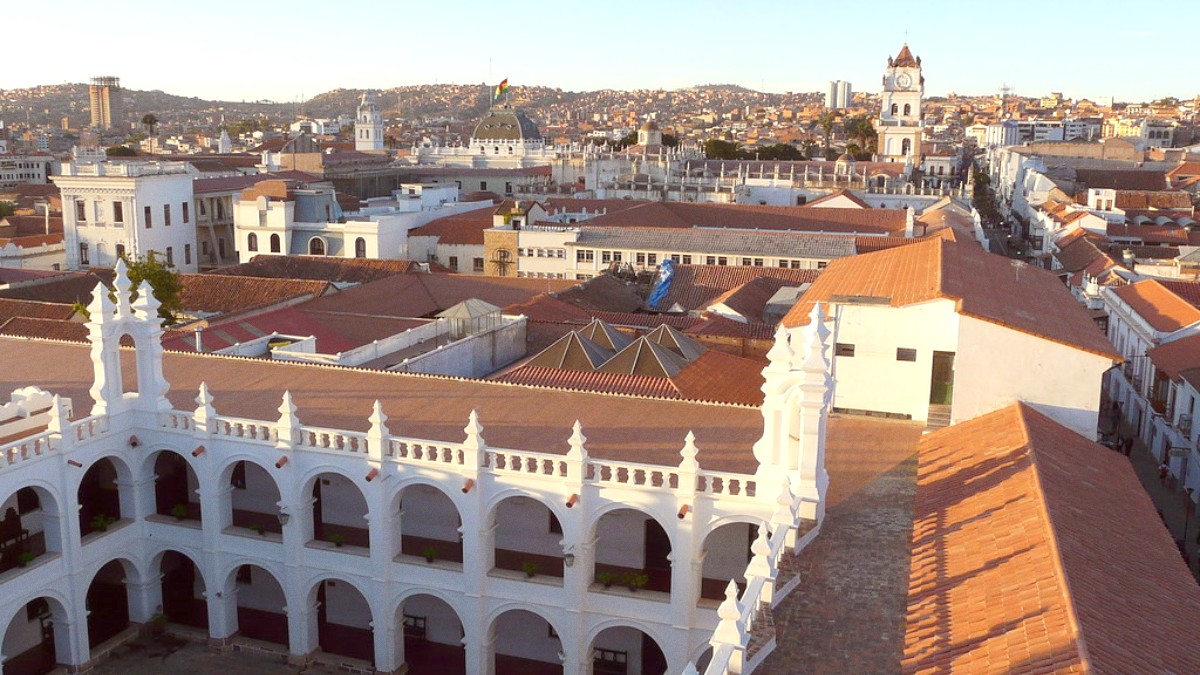
The Southwest, Bolivia
The central square of Sucre. Named after the city’s first cry for independence on May 25, 1809. This beautiful plaza is the social heart of Sucre. Important historical buildings surround it, including the Casa de la Libertad, the Metropolitan Cathedral, and the Prefectura (government building). It is a pleasant place to relax, people-watch, and absorb the city’s atmosphere.
Convento de San Felipe Neri hours/fees are similar to La Recoleta. The main draw here is the rooftop access. Plan your visit for good light for the best photos.
Approximately 5 km north of Sucre. The world's largest collection of dinosaur footprints on a near-vertical cliff face. A remarkable paleontological wonder. Hours: Tue-Sun 9:00 AM-5:00 PM. Fees: 30 BOB for park entry. Additional small fee for guided "Mirador" tour.
The entire area is a living museum of colonial architecture. Uniform white buildings, red tile roofs, ornate wooden balconies, and traditional courtyards. Wander the streets beyond the main plaza.
San Francisco Church: One of the oldest churches (16th century). Historically distinguished for its tower, from which the bell of independence first rang. Santo Domingo Church: Another significant colonial church with beautiful architecture.
Statues and monuments around Plaza 25 de Mayo commemorate Bolivia's independence heroes. The Casa de la Libertad is the nation's main memorial to its independence.
While Sucre is a city, it also has access to pleasant parks and viewpoints for natural beauty.
Adjacent to the Cal Orcko dinosaur footprint site. This park has life-size dinosaur replicas, a museum, and a viewpoint for the footprints. An engaging and educational experience, good for families.
A pleasant urban park in the city center, popular with local families. It has a miniature replica of the Eiffel Tower, beautiful fountains, and green spaces.
Has the most iconic and comprehensive panoramic views of Sucre, with its white buildings across the valley.
Another viewpoint with city panoramas, often less crowded than La Recoleta, with a different perspective.
Limited within Sucre. Significant wildlife viewing (jaguars, capybaras) is mainly in national parks in other Bolivian regions (e.g., Madidi National Park), which need separate travel arrangements.
The vast expanse of dinosaur footprints on a cliff face is an unique geological phenomenon, showing the region's ancient past. Beaches, lakes, and waterways are not applicable to Sucre, as it is an inland city.
Beyond the main tourist circuit, Sucre holds several less-visited but intriguing spots.
Cemetery General de Sucre: Beautiful and well-maintained, with ornate mausoleums. A unique, contemplative glimpse into historical and social aspects of Sucre. Mercado Campesino: A sprawling local market, larger and more chaotic than Mercado Central. An authentic glimpse into local life.
Rooftops of San Felipe Neri and La Recoleta have stunning cityscapes, notably at sunset or sunrise. The crisp white colonial facades against Sucre's often bright blue sky create striking contrasts for photography.
Mirador de Sica Sica: Another hill with panoramic views of the city, often less crowded than La Recoleta. A peaceful setting for reflection and photography. Local Panaderías: Explore small, neighborhood bakeries (panaderías) for fresh bread, pastries like pan de queso, or salteñas (in the mornings).
The impressive dinosaur footprints at Cal Orcko, a short distance from Sucre.
The image showcases the vast expanse of dinosaur footprints on a cliff face at Cal Orcko, near Sucre. This site holds the world's largest collection of dinosaur tracks.
This unique geological phenomenon reveals the region's ancient past, making it a destination for paleontology enthusiasts and families.
Cal Orcko is approximately 5 km north of Sucre, making it an accessible and worthwhile half-day trip for visitors.
For sites like Casa de la Libertad and Cal Orcko, guided tours are available and often recommended for historical context. Many include the entrance fee.
Book tours with GetYourGuideEntrance fees for museums and attractions are generally modest. Purchase tickets at the entrance. For some popular sites, online booking is possible.
Check ticket availability hereAlways check the latest opening hours for attractions before your visit. Hours can vary, especially on holidays.
Observe signs regarding photography restrictions in museums and religious sites. Some places restrict flash photography or have certain areas where photos are not allowed.
Many historical buildings in Sucre have uneven surfaces, stairs, and cobblestone streets. Accessibility for those with mobility challenges can be limited.
Explore Sucre's deep historical roots through its churches and monuments.
Wear comfortable shoes for walking on cobblestone streets. Hydrate often due to Sucre's altitude.
Consider purchasing a local SIM card for easy navigation and communication.
Explore less-visited yet captivating sites for an unique perspective of Sucre.
Discover unique aspects of Sucre away from the main tourist circuit.
Experience the authentic daily life of Sucre at its bustling local markets.
Find peaceful spots and local culinary delights.
Local Panaderías: Explore small, neighborhood bakeries for fresh bread, pastries like pan de queso, or salteñas (in the mornings). These local spots have authentic tastes and a chance to interact with locals.
Discover the cultural depth beyond Sucre's city limits.
Camino del Inca (El Choro): This historical route is a challenging adventure and cultural immersion. It is often accessed via multi-day treks from Sucre, for those seeking more rigorous exploration.
Find picturesque spots for memorable photographs.
These unique settings create stunning backdrops for your travel photography, highlighting Sucre's distinct charm.
This museum within the La Recoleta monastery exhibits religious art, colonial artifacts, and historical items related to the Franciscan order.
Often visited with the Ethnographic Museum, this museum specifically focuses on the rich textile traditions of the Andes, showing intricate artistry.
This university museum has collections on anthropology, archaeology, and ethnography of Bolivia, for a broader academic perspective on the country's diverse heritage.